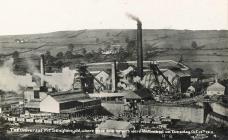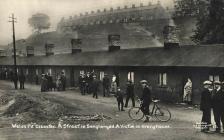Disaster at Senghenydd
Items in this story:
Dangerous conditions
On Tuesday 14 October 1913, the most serious mining disaster in the history of the Welsh coal industry occurred at Senghenydd near Caerphilly. The village of Senghenydd had grown around the Universal Steam Coal Company pit when mining began there during the 1890s. The expansion of the South Wales coalfield and the increasing demand for coal saw pits become deeper and busier with an emphasis on productivity and profitability. Working in deep pits was dangerous and the conditions were poor; working in confined spaces, flooding, gas leaks and coal dust were a constant hazard and a part of daily life for the miners.
'The tragic aspect of the coal industry'
In 1913, the prosperity of the coalfield reached its peak, when over forty-six million tonnes of coal were produced. However, sadly, in the same year, what Dr John Davies has described as ‘the tragic aspect of the coal industry’ also reached its climax in the Senghenydd disaster. 439 men and boys were killed by the explosion which destroyed the western side of the pit on Tuesday 14 October. There had been a severe explosion in 1901 in which 82 workers were killed. Following that incident a number of recommendations were made regarding safety in deep pits and though everyone was aware of the serious dangers involved, both production and the number of miners working under these dangerous conditions increased.
One spark
The explosion was probably caused by a build up of methane gas ignited by a spark which then caused the highly flammable coaldust on the walls and floors to ignite. The explosion then travelled through most of the pit workings and those men not killed instantly by the fire would have been suffocated by the build up of noxious gases underground.
Both the manager and the owners of the pit were prosecuted but, much to the disappointment of the grieving families, all charges were dropped against the owners and the manager was made to pay a fine of £24. On appeal the owners were ordered to pay a fine of £10 and costs of £5.5s.
Mining continued at the pit until 1928. There exist three memorials to the victims; the first was unveiled in 1981.


